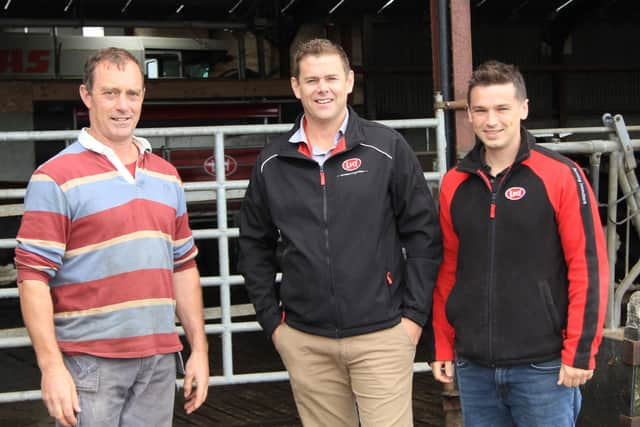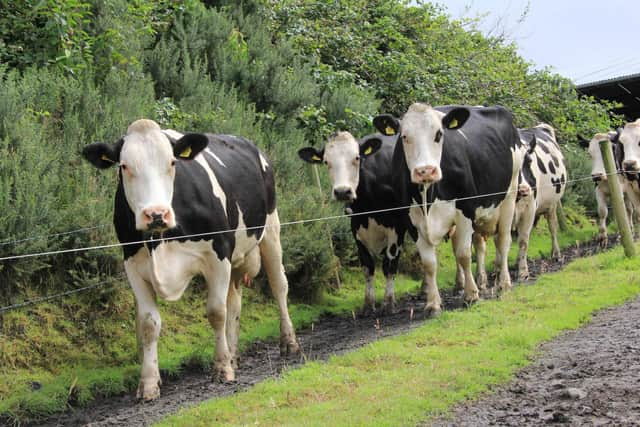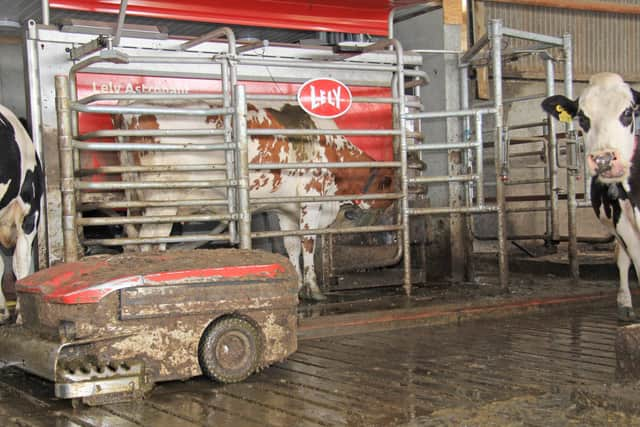Grazing, milking robots and cross-breeding the focus of Lely open day
and live on Freeview channel 276
The one-day event on Thursday 18th August will be hosted by John Killen, who farms in partnership with his uncle Clarke, at 41 Cloghole Road, Campsie, Londonderry, BT47 3JW. Visitors are welcome between 11.00am and 3.00pm.
“With escalating costs on farms, fresh grass remains the most cost-effective forage for dairy cows,“ explained Dean Cashel from Lely Center Eglish. “Next week’s open day is designed to showcase how Lely’s Grazeway system works in tandem with the Astronaut milking robots, to give farmers the option of managing cows at grass.
Advertisement
Advertisement
“There is huge misconception that robot farms cannot graze cows on a daily basis. Lely’s Grazeway system provides flexibility for farmers, and gives cows the freedom to manage their own time.”


John and Clarke Killen farm 500 acres, almost half of which is attributed to growing arable crops such as barley and wheat. A 20-acre crop of red clover has been planted for the first this year as a high protein alternative to bought-in soya. The farm is home to a 150-cow commercial dairy herd, and a beef enterprise finishing up to 80 head per annum.
An increasing workload, coupled with a lack of labour, prompted John to consider investing in robotic milking technology. “We were milking in a modern 20-point swing-over parlour, but switching to three times-a-day milking wasn’t an option due to a shortage of labour,” explained John.
After exploring the various options available, John opted for the Lely’s Astronaut A5 robot. “I was impressed with the A5’s superior and energy efficient hybrid arm, and the iflow design giving cows obstacle-free entry and access to the robot,” explained Greenmount College graduate John.
Advertisement
Advertisement
“I also like to see cows out at grass, and the Lely Grazeway gives me the flexibility to graze cows between April and mid-October.”


The farm’s first Lely Astronaut A5 was installed in November 2018. “From the outset I was very impressed, and the results were much better than I expected,” added John. “We put 55 fresh calved cows, regardless of age and yield, on to the robotic system. They took to it like a duck to water, averaging 3.4 milkings per day which proved beneficial in terms of yield and animal welfare.”
A second robot was introduced in September 2019, followed by a third in February 2022. “We were able to install the robots in our existing sheds with minimal fuss. The robots are a real success!” exclaimed John.
“I’ll be truthful, I was sceptical about robots, and six or seven years ago I would have completely dismissed the idea. Now I have experienced the multiple physical and financial benefits, I would be reluctant to go back to conventional milking in a parlour.
Advertisement
Advertisement
“The time I’m saving can be invested in other areas around the farm, and I’ve more free time to spend with family and friends. The system is fully automated and fool-proof, and information on each individual cow can be accessed via a computer, or remotely using a smart phone.”


John continued: “Lely’s T4C software is an essential tool. I have access to a lot more management data, and the conductivity, rumination and activity meters are invaluable.”
Milk is sold to Lakeland Dairies, and the herd is averaging over 10,500 litres of milk at 4.1% fat and 3.3% protein per cow per year.
“This is our second season using the Grazeway, and we are using an A, B and C rotation which changes at eight hourly intervals every day. The grazing platform totals 30 acres. From 3am to 11am the cows have access to paddock A, and from 11am to 7pm they can graze paddock B; while C represents overnight in the shed.”
Advertisement
Advertisement
During the winter housing period the cows are fed a TMR ration which is formulated for maintenance plus 30 litres. The diet comprises of grass silage, straw, wholecrop, crimped wheat and blend. The buffer feed ration during the grazing season is made up of round bale silage, straw and dairy blend. Additional concentrates are fed in the robot, according to individual yield, at a rate of 0.3kgs per litre of milk. The robot has the ability to feed two different concentrate rations, 20% and 16% protein nuts.
The commercial dairy herd embarked on a three-way cross – Holstein, Norwegian Red and Fleckvieh - breeding programme seven or eight years ago. “The Holstein cows were getting too big and hard to manage. Cross-breeding offers many benefits, including improved health and fertility, and can be used as a tool to control cow size,” added John.
“It’s the way to go! The cows are easier to manage, and traits such as feet and legs, fertility and longevity are all improved; and I haven’t noticed a big difference in milk quantity.”
John uses sexed semen from proven AI sires, and is very satisfied with the results, especially the stature and body condition of the cows. An Aberdeen Angus bull is used as a sweeper, and the calves are reared and finished on-farm, achieving a producer scheme bonus at slaughter.
Advertisement
Advertisement
“The milk cows are content and healthy, and are lasting longer. Cows are culled because of old age, rather than feet, udder or health issues. Cross-bred cull cows are also more valuable,” said John, who recently sold a nine-year-cow at Kilrea for £1,490.
John and Clarke have also invested in a Lely Discovery Collector, a revolutionary robot which cleans manure from solid and slatted shed floors. “It’s a brilliant ‘vacuum cleaner’ for cow sheds!” concluded John. “It keeps the shed clean, which has resulted in healthier hooves and udders, and cleaner and cubicles.”
Progressive dairy farmers are invited to attend the forthcoming Lely Open Day, which will include representatives from a number of other companies including Keenan, DLF Seeds and nutritionist David Mawhinney, Clonleigh Co-op.
For further information contact Lely Center Eglish on tel: 028 3754 8228, Jim Irwin on 07827 884639, or Dean Cashel on 07887 421563.